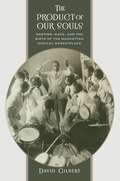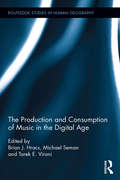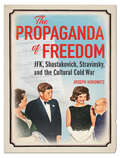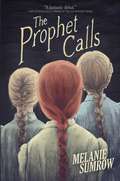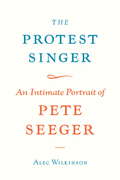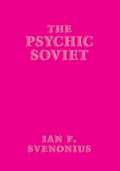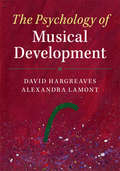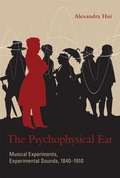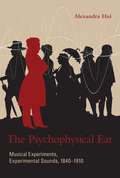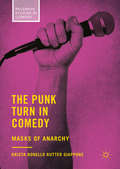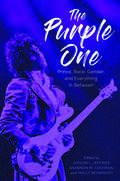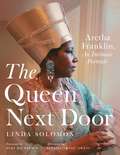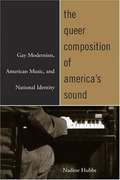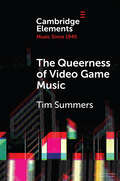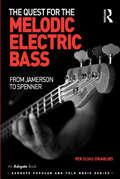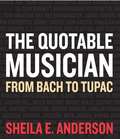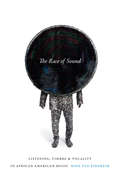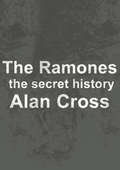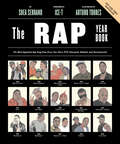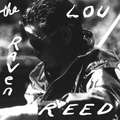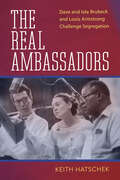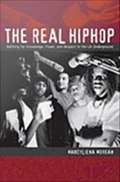- Table View
- List View
The Product of Our Souls
by David GilbertIn 1912 James Reese Europe made history by conducting his 125-member Clef Club Orchestra at Carnegie Hall. The first concert by an African American ensemble at the esteemed venue was more than just a concert--it was a political act of desegregation, a defiant challenge to the status quo in American music. In this book, David Gilbert explores how Europe and other African American performers, at the height of Jim Crow, transformed their racial difference into the mass-market commodity known as "black music." Gilbert shows how Europe and others used the rhythmic sounds of ragtime, blues, and jazz to construct new representations of black identity, challenging many of the nation's preconceived ideas about race, culture, and modernity and setting off a musical craze in the process.Gilbert sheds new light on the little-known era of African American music and culture between the heyday of minstrelsy and the Harlem Renaissance. He demonstrates how black performers played a pioneering role in establishing New York City as the center of American popular music, from Tin Pan Alley to Broadway, and shows how African Americans shaped American mass culture in their own image.
The Production and Consumption of Music in the Digital Age (Routledge Studies in Human Geography #58)
by Tarek E. Virani Brian J. Hracs Michael SemanThe economic geography of music is evolving as new digital technologies, organizational forms, market dynamics and consumer behavior continue to restructure the industry. This book is an international collection of case studies examining the spatial dynamics of today’s music industry. Drawing on research from a diverse range of cities such as Santiago, Toronto, Paris, New York, Amsterdam, London, and Berlin, this volume helps readers understand how the production and consumption of music is changing at multiple scales – from global firms to local entrepreneurs; and, in multiple settings – from established clusters to burgeoning scenes. The volume is divided into interrelated sections and offers an engaging and immersive look at today’s central players, processes, and spaces of music production and consumption. Academic students and researchers across the social sciences, including human geography, sociology, economics, and cultural studies, will find this volume helpful in answering questions about how and where music is financed, produced, marketed, distributed, curated and consumed in the digital age.
The Propaganda of Freedom: JFK, Shostakovich, Stravinsky, and the Cultural Cold War (Music in American Life)
by Joseph HorowitzThe perils of equating notions of freedom with artistic vitality Eloquently extolled by President John F. Kennedy, the idea that only artists in free societies can produce great art became a bedrock assumption of the Cold War. That this conviction defied centuries of historical evidence--to say nothing of achievements within the Soviet Union--failed to impact impregnable cultural Cold War doctrine. Joseph Horowitz writes: “That so many fine minds could have cheapened freedom by over-praising it, turning it into a reductionist propaganda mantra, is one measure of the intellectual cost of the Cold War.” He shows how the efforts of the CIA-funded Congress for Cultural Freedom were distorted by an anti-totalitarian “psychology of exile” traceable to its secretary general, the displaced Russian aristocrat/composer Nicolas Nabokov, and to Nabokov’s hero Igor Stravinsky. In counterpoint, Horowitz investigates personal, social, and political factors that actually shape the creative act. He here focuses on Stravinsky, who in Los Angeles experienced a “freedom not to matter,” and Dmitri Shostakovich, who was both victim and beneficiary of Soviet cultural policies. He also takes a fresh look at cultural exchange and explores paradoxical similarities and differences framing the popularization of classical music in the Soviet Union and the United States. In closing, he assesses the Kennedy administration’s arts advocacy initiatives and their pertinence to today’s fraught American national identity. Challenging long-entrenched myths, The Propaganda of Freedom newly explores the tangled relationship between the ideology of freedom and ideals of cultural achievement.
The Prophet Calls
by Melanie SumrowGentry Forrester feels lucky to live among God’s chosen people in the Prophet's compound, but when music is outlawed, Gentry and her older brother, Tanner, sneak out of the community. When they return, all bets are off as the Prophet exercises his control.Born into a polygamous community in the foothills of New Mexico, Gentry Forrester feels lucky to live among God’s chosen. Here, she lives apart from the outside world and its “evils.” On her thirteenth birthday, Gentry receives a new violin from her father and, more than anything, she wants to play at the Santa Fe Music Festival with her brother, Tanner. But then the Prophet calls from prison and announces he has outlawed music in their community and now forbids women to leave. Determined to play, Gentry and Tanner sneak out. But once they return, the Prophet exercises control from prison, and it has devastating consequences for Gentry and her family. Soon, everything Gentry has known is turned upside down. She begins to question the Prophet’s teachings and his revelations, especially when his latest orders put Gentry’s family in danger. Can Gentry find a way to protect herself and her family from the Prophet and escape the only life she’s ever known? This realistic, powerful story of family, bravery, and following your dreams is a can't-miss debut novel from Melanie Sumrow.
The Protest Singer: An Intimate Portrait of Pete Seeger
by Alec WilkinsonA spirited and intimate look at American icon and activist Pete Seeger. Throughout his life, Pete Seeger transformed a classic American musical style into a form of peaceful protest against war, segregation, and nuclear weapons. Drawing on his extensive talks with Seeger, Alec Wilkinson delivers a first hand look at Seeger's unique blend of independence and commitment, charm, courage, energy, and belief in human equality and American democracy. We see Seeger as a child, instilled with a love of music by his parents; as a teenager, hearing real folk music for the first time; as a young adult, singing with Woody Guthrie. And finally, Seeger the man marching with the Rev. Martin Luther King in Selma, standing up to McCarthyism, and fighting for his beloved Hudson River. The gigantic life captured in this slender volume is truly an American anthem.
The Psychic Soviet
by Ian F. SvenoniusA reissue of Ian F. Svenonius's cult-classic debut essay collection, including brand-new writing in this expanded edition. "Everything author-slash-punk-icon Ian Svenonius says is interesting, and this book of satirical essays--originally publ
The Psychology of Musical Development
by David Hargreaves Alexandra LamontThe Psychology of Musical Development provides an up-to-date and comprehensive account of the latest theory, empirical research and applications in the study of musical development, an important and emerging field of music psychology. After considering how people now engage with music in the digital world, and reviewing current advances in developmental and music psychology, Hargreaves and Lamont compare ten major theoretical approaches in this field - including cognitive stage models and neuroscientific, ecological and social cognitive approaches - and assess how successfully each of these deals with five critical theoretical issues. Individual chapters deal next with cognition, perception and learning; social development; environmental influences on ability, achievement and motivation; identity, personality and lifestyle; affect and emotion; and well-being and health. With an emphasis on practical applications throughout, this book will be essential reading for students and scholars of music psychology, developmental psychology, music education and music therapy.
The Psychophysical Ear
by Alexandra HuiIn the middle of the nineteenth century, German and Austrian concertgoers began to hear new rhythms and harmonies as non-Western musical ensembles began to make their way to European cities and classical music introduced new compositional trends. At the same time, leading physicists, physiologists, and psychologists were preoccupied with understanding the sensory perception of sound from a psychophysical perspective, seeking a direct and measurable relationship between physical stimulation and physical sensation. These scientists incorporated specific sounds into their experiments--the musical sounds listened to by upper middle class, liberal Germans and Austrians. In The Psychophysical Ear, Alexandra Hui examines this formative historical moment, when the worlds of natural science and music coalesced around the psychophysics of sound sensation, and new musical aesthetics were interwoven with new conceptions of sound and hearing. Hui, a historian and a classically trained musician, describes the network of scientists, musicians, music critics, musicologists, and composers involved in this redefinition of listening. She identifies a source of tension for the psychophysicists: the seeming irreconcilability between the idealist, universalizing goals of their science and the increasingly undeniable historical and cultural contingency of musical aesthetics. The convergence of the respective projects of the psychophysical study of sound sensation and the aesthetics of music was, however, fleeting. By the beginning of the twentieth century, with the professionalization of such fields as experimental psychology and ethnomusicology and the proliferation of new and different kinds of music, the aesthetic dimension of psychophysics began to disappear.
The Psychophysical Ear: Musical Experiments, Experimental Sounds, 1840-1910 (Transformations: Studies in the History of Science and Technology)
by Alexandra HuiAn examination of how the scientific study of sound sensation became increasingly intertwined with musical aesthetics in nineteenth-century Germany and Austria.In the middle of the nineteenth century, German and Austrian concertgoers began to hear new rhythms and harmonies as non-Western musical ensembles began to make their way to European cities and classical music introduced new compositional trends. At the same time, leading physicists, physiologists, and psychologists were preoccupied with understanding the sensory perception of sound from a psychophysical perspective, seeking a direct and measurable relationship between physical stimulation and physical sensation. These scientists incorporated specific sounds into their experiments—the musical sounds listened to by upper middle class, liberal Germans and Austrians. In The Psychophysical Ear, Alexandra Hui examines this formative historical moment, when the worlds of natural science and music coalesced around the psychophysics of sound sensation, and new musical aesthetics were interwoven with new conceptions of sound and hearing.Hui, a historian and a classically trained musician, describes the network of scientists, musicians, music critics, musicologists, and composers involved in this redefinition of listening. She identifies a source of tension for the psychophysicists: the seeming irreconcilability between the idealist, universalizing goals of their science and the increasingly undeniable historical and cultural contingency of musical aesthetics. The convergence of the respective projects of the psychophysical study of sound sensation and the aesthetics of music was, however, fleeting. By the beginning of the twentieth century, with the professionalization of such fields as experimental psychology and ethnomusicology and the proliferation of new and different kinds of music, the aesthetic dimension of psychophysics began to disappear.
The Punk Turn in Comedy: Masks Of Anarchy (Palgrave Studies in Comedy)
by Krista Bonello Rutter GiapponeThis book examines the interconnections between punk and alternative comedy (altcom). It explores how punk’s tendency towards humour and parody influenced the trajectory taken by altcom in the UK, and the punk strategies introduced when altcom sought self-definition against dominant established trends. The Punk Turn in Comedy considers the early promise of punk-comedy convergence in Peter Cook and Dudley Moore’s ‘Derek and Clive’, and discusses punk and altcom’s attitudes towards dominant traditions. The chapters demonstrate how punk and altcom sought a direct approach for critique, one that rejected innuendo, while embracing the ‘amateur’ in style and experimenting with audience-performer interaction. Giappone argues that altcom tended to be more consistently politicised than punk, with a renewed emphasis on responsibility. The book is a timely exploration of the ‘punk turn’ in comedy history, and will speak to scholars of both comedy and punk studies.
The Puppy Pianist: A fun children's book for boys and girls age 6 and up
by A. P. HernándezWilliam’s a piano teacher and Lola is his inseparable Maltese Bichon dog. Lola has always been surrounded by music because she loves listening to her owner play his wonderful instrument. One day, Lola decides to jump onto the piano bench. She’s very clear about it: she is going to be a puppy pianist. What's inside? •A fun story with numerous illustrations to make reading more enjoyable. •A captivating tale to encourage the habit of reading; it offers children a story that matches their interests. Educational value of this book: •Increases vocabulary. •Promotes self-esteem because Lola's story can help children feel more confident. •Teaches children that we all have special talents that make us unique and valuable. •Fosters resilience because Lola confronts challenges throughout the story. A children's book for ages 6 and up.
The Purple One: Prince, Race, Gender, and Everything in Between (American Made Music Series)
by Judson L. Jeffries, Shannon M. Cochran, and Molly ReinhoudtContributions by Cassandra D. Chaney, Shannon M. Cochran, Samuel P. Fitzpatrick, Judson L. Jeffries, Zada Johnson, Tony Kiene, Aaron J. Kimble, Jerod Lockhart, Molly Reinhoudt, Paul N. Reinsch, Laurel Westrup, and Sherman M. WhitePrince (1958–2016) looms large in contemporary music history. Despite universal acclaim for his artistry, few scholars and writers have thoroughly treated the underlying ideas expressed in his work or examined his profound impact on popular culture. The Purple One: Prince, Race, Gender, and Everything in Between positions Prince in his proper cultural, political, and social place in history.Contributors employ a diverse range of approaches to explore the intricate facets of this cultural icon, illuminating the many dimensions of his creative output and legacy. The collection is organized around two central themes that shed light on Prince’s artistry and lasting influence. Moving beyond conventional discussions about Prince and masculinity, part I, “Black Masculinity and Gender Performativity,” delves into less-explored aspects of the artist’s gender-bending persona. Essays in this section cover a slew of fascinating subjects, including Prince’s re-scripting of Black masculinity in the cult classic Under the Cherry Moon and an autoethnographic study of African American father-son relationships in the film Purple Rain. Another essay examines the subversive gender performativity of Prince and frequent collaborator Sheila E.Part II, “Beauty, Race, and Spirituality,” explores a range of topics present in Prince’s oeuvre, from the sociopolitical contours of his work to his overlooked but significant projects and protégés. Contributors in this section examine Prince’s representations of female beauty, his articulations of urban rage and protest, and his commercially successful but critically overlooked Batman soundtrack. This second installment of the ongoing scholarly project, PrincEnlighteNmenT: A Study of Society through Music, continues to center Prince as a focal point in music scholarship and enhance our understanding of his complex life and work.
The Quarter Note Cowpoke
by James Potter Gale Potter"His parents were puffed up, near bursting with pride. However, their dreams and his dreams did not coincide."
The Queen Next Door: Aretha Franklin, An Intimate Portrait (Painted Turtle)
by Linda Solomon"Aretha was private. I respected this and she trusted me." Linda Solomon met Aretha Franklin in 1983 when she was just beginning her career as a photojournalist and newspaper columnist. Franklin’s brother and business manager arranged for Solomon to capture the singer’s major career events—just as she was coming back home to Detroit from California—while Franklin requested that Solomon document everything else. Everything. And she did just that. What developed over these years of photographing birthday and Christmas parties in her home, annual celebrity galas, private backstage moments during national awards ceremonies, photo shoots with the iconic pink Cadillac, and more was a friendship between two women who grew to enjoy and respect one another. The Queen Next Door: Aretha Franklin, An Intimate Portrait is a book full of firsts as Solomon was invited not only to capture historical events in Aretha’s music career showcasing Detroit but to join in with the Franklin family’s most intimate and cherished moments in her beloved hometown. From performance rehearsals with James Brown to off-camera shenanigans while filming a music video with the Rolling Stones, from her first television special to her first time performing with the Detroit Symphony Orchestra, to her last performance with her sisters at her father’s church and her son’s college graduation celebration. In the book’s afterword, Sabrina Vonne' Owens, Franklin’s niece, honors her aunt, a woman who was an overwhelming supporter of civil rights, women’s rights, and fundraising campaigns that helped to benefit her hometown. There was a time in her career—when Franklin was more in demand than ever before—when she insisted that if someone wanted her to perform, they had to come to Detroit. During this time all of her major concerts, national television specials, music videos, and commercials would happen in Detroit. Aretha Franklin showed her respect for the people in the city who championed her from the very beginning when she started singing as a young girl in the church choir. Franklin used to say, "I am the lady next door when I am not on stage." The Queen Next Door offers fans a personal and unseen look at an extraordinary woman in her most natural moments—both regal and intimate—and highlights her devotion to her family and her hometown Detroit—"forever and ever."
The Queer Composition of America's Sound: Gay Modernists, American Music, and National Identity
by Nadine HubbsNadine Hubbs shows how a gifted group of Manhattan-based gay composers were pivotal in creating a distinctive "American sound" and in the process served as architects of modern American identity. Focusing on a talented circle that included Aaron Copland, Virgil Thomson, Leonard Bernstein, Marc Blitzstein, Paul Bowles, David Diamond, and Ned Rorem, The Queer Composition of America's Sound homes in on the role of these artists' self-identification.
The Queerness of Video Game Music (Elements in Music since 1945)
by Tim SummersVideo game music is a significant site of queerness where normative demands are questioned, suspended or loosened. Games resist hegemonic musical logics, challenge musical value systems and use music to complicate essentialist notions of identity. This Element proposes three areas of queerness, each representing different relationships between 'queer design' and 'queer engagement', ranging fromunintentionally resistive to explicit engagement with identity. First, this Element examines musical structures that provide queer temporal alternatives to normative linear development, and interactive systems that reframe the power relationship between musical material and listener. Second, it considers 'retro' or 'chiptune' timbres that queer notions of technological progress to be improvements, rejecting chrononormativity. Finally, the Element discusses music that queers the self/other binary of identity. Games present ways of listening to, engaging with and understanding music that provide opportunities to challenge inherited assumptions and reductive or monolithic values, practices and identities.
The Quest for the Melodic Electric Bass: From Jamerson to Spenner (Ashgate Popular and Folk Music Series)
by Per Elias DrabløsThe double bass - the preferred bass instrument in popular music during the 1960s - was challenged and subsequently superseded by the advent of a new electric bass instrument. From the mid-1960s and throughout the 1970s, a melismatic and inconsistent approach towards the bass role ensued, which contributed to a major change in how the electric bass was used in performance and perceived in the sonic landscape of mainstream popular music. Investigating the performance practice of the new, melodic role of the electric bass as it appeared (and disappeared) in the 1960s and 1970s, the book turns to the number one songs of the American Billboard Hot 100 charts between 1951 and 1982 as a prime source. Through interviews with players from this era, numerous transcriptions - elaborations of twenty bass related features - are presented. These are juxtaposed with a critical study of four key players, who provide the case-studies for examining the performance practice of the melodic electric bass. This highly original book will be of interest not only to bass players, but also to popular musicologists looking for a way to instigate methodological and theoretical discussions on how to develop popular music analysis.
The Quilting Points of Musical Modernism: Revolution, Reaction, and William Walton
by J. P. E. Harper-ScottModernism is both a contested aesthetic category and a powerful political statement. Modernist music was condemned as degenerate by the Nazis and forcibly replaced by socialist realism under the Soviets. Sympathetic philosophers and critics have interpreted it as a vital intellectual defence against totalitarianism, yet some American critics consider it elitist, undemocratic and even unnatural. Drawing extensively on the philosophy of Heidegger and Badiou, The Quilting Points of Musical Modernism proposes a new dialectical theory of faithful, reactive and obscure subjective responses to musical modernism, which embraces all the music of Western modernity. This systematic definition of musical modernism introduces readers to theory by Badiou, Žižek and Agamben. Basing his analyses on the music of William Walton, Harper-Scott explores connections between the revolutionary politics of the nineteenth and twentieth centuries and responses to the event of modernism in order to challenge accepted narratives of music history in the twentieth century.
The Quotable Musician: From Bach to Tupac
by Sheila E. AndersonFor those looking for a little more from musicians and composers than music here are quotations of wit and wisdom, anger and admission. Material is divided into 30 topics such as identity, humor, conducting, other musicians, wisdom, and society. Also featured are short interviews with Ron Carter, a discussion about Thelonious Sphere Monk with his son, and Benny Golson. Musicians and composers run the genre gamut, with jazz, classical, and popular musics featured most predominantly. Anderson is the host of Sunday Morning Harmony on WBGO in Newark. The book is geared to a popular readership. Annotation (c)2003 Book News, Inc. , Portland, OR (booknews. com)
The Race of Sound: Listening, Timbre, and Vocality in African American Music (Refiguring American Music)
by Nina Sun EidsheimIn The Race of Sound Nina Sun Eidsheim traces the ways in which sonic attributes that might seem natural, such as the voice and its qualities, are socially produced. Eidsheim illustrates how listeners measure race through sound and locate racial subjectivities in vocal timbre—the color or tone of a voice. Eidsheim examines singers Marian Anderson, Billie Holiday, and Jimmy Scott as well as the vocal synthesis technology Vocaloid to show how listeners carry a series of assumptions about the nature of the voice and to whom it belongs. Outlining how the voice is linked to ideas of racial essentialism and authenticity, Eidsheim untangles the relationship between race, gender, vocal technique, and timbre while addressing an undertheorized space of racial and ethnic performance. In so doing, she advances our knowledge of the cultural-historical formation of the timbral politics of difference and the ways that comprehending voice remains central to understanding human experience, all the while advocating for a form of listening that would allow us to hear singers in a self-reflexive, denaturalized way.
The Ramones: The Secret History (The\secret History Of Rock Ser.)
by Alan CrossAlan Cross is the preeminent chronicler of popular music.Here he provides a history of alt-rock pioneers The Ramones.This look at the band—"Four Leather Jackets, Two Chords and an Attitude"—is adapted from the audiobook of the same name.
The Rap Year Book: The Most Important Rap Song From Every Year Since 1979, Discussed, Debated, and Deconstructed
by Shea SerranoA New York Times–bestselling, in-depth exploration of the most pivotal moments in rap music from 1979 to 2014.Here’s what The Rap Year Book does: It takes readers from 1979, widely regarded as the moment rap became recognized as part of the cultural and musical landscape, and comes right up to the present, with Shea Serrano hilariously discussing, debating, and deconstructing the most important rap song year by year. Serrano also examines the most important moments that surround the history and culture of rap music—from artists’ backgrounds to issues of race, the rise of hip-hop, and the struggles among its major players—both personal and professional. Covering East Coast and West Coast, famous rapper feuds, chart toppers, and show stoppers, The Rap Year Book is an in-depth look at the most influential genre of music to come out of the last generation. Picked by Billboard as One of the 100 Greatest Music Books of All-TimePitchfork Book Club’s first selection
The Raven (Books That Changed the World)
by Lou ReedThe legendary musician’s distinctive artistic take on Edgar Allan Poe includes “some of the most personal lyrics of his career” (Rolling Stone).One of the most influential and innovative recording artists of the past three decades, Lou Reed has always offered a shrewd view of life in the big city in all its colors. It is no surprise, then, that he considers Edgar Allan Poe a spiritual forefather. In The Raven, Reed immerses himself in Poe’s enigmatic world and sets out to reimagine his work to mesmerizing effect. In 2001 Lou Reed, legendary theater director Robert Wilson, and an all-star cast presented the musical POEtry at the Brooklyn Academy of Music. Reed’s subsequent studio adaptation, The Raven, has been hailed as one of his more daring and challenging albums. Here, accompanied by photographs by the acclaimed artist and director Julian Schnabel, is the definitive text of the CD release. The Raven includes Reed's distinctive takes on Poe’s most celebrated works, as well as song lyrics written for the musical. It is a fascinating meeting between a dark chronicler of the twentieth century and his nineteenth-century counterpart; the work of one iconoclastic genius offering a haunting exploration of another.
The Real Ambassadors: Dave and Iola Brubeck and Louis Armstrong Challenge Segregation (American Made Music Series)
by Keith HatschekWinner of the 2023 ASCAP Foundation Deems Taylor/Virgil Thomson Book AwardRecipient of a 2023 Certificate of Merit for Best Historical Research in Recorded Jazz from the Association for Recorded Sound CollectionsKeith Hatschek tells the story of three determined artists: Louis Armstrong, Dave Brubeck, and Iola Brubeck and the stand they took against segregation by writing and performing a jazz musical titled The Real Ambassadors. First conceived by the Brubecks in 1956, the musical’s journey to the stage for its 1962 premiere tracks extraordinary twists and turns across the backdrop of the civil rights movement. A variety of colorful characters, from Broadway impresarios to gang-connected managers, surface in the compelling storyline. During the Cold War, the US State Department enlisted some of America’s greatest musicians to serve as jazz ambassadors, touring the world to trumpet a so-called “free society.” Honored as celebrities abroad, the jazz ambassadors, who were overwhelmingly African Americans, returned home to racial discrimination and deferred dreams. The Brubecks used this double standard as the central message for the musical, deploying humor and pathos to share perspectives on American values. On September 23, 1962, The Real Ambassadors’s stunning debut moved a packed arena at the Monterey Jazz Festival to laughter, joy, and tears. Although critics unanimously hailed the performance, it sadly became a footnote in cast members’ bios. The enormous cost of reassembling the star-studded cast made the creation impossible to stage and tour. However, The Real Ambassadors: Dave and Iola Brubeck and Louis Armstrong Challenge Segregation caps this jazz story by detailing how the show was triumphantly revived in 2013 by the Detroit Jazz Festival and in 2014 by Jazz at Lincoln Center. This reaffirmed the musical’s place as an integral part of America’s jazz history and served as an important reminder of how artists’ voices are a powerful force for social change.
The Real Hiphop: Battling for Knowledge, Power, and Respect in the LA Underground
by Marcyliena MorganProject Blowed is a legendary hiphop workshop based in Los Angeles. It began in 1994 when a group of youths moved their already renowned open-mic nights from the Good Life, a Crenshaw district health food store, to the KAOS Network, an arts center in Leimert Park. The local freestyle of articulate, rapid-fire, extemporaneous delivery, the juxtaposition of meaningful words and sounds, and the way that MCs followed one another without missing a beat, quickly became known throughout the LA underground. Leimert Park has long been a center of African American culture and arts in Los Angeles, and Project Blowed inspired youth throughout the city to consider the neighborhood the epicenter of their own cultural movement. The Real Hiphop is an in-depth account of the language and culture of Project Blowed, based on the seven years Marcyliena Morgan spent observing the workshop and the KAOS Network. Morgan is a leading scholar of hiphop, and throughout the volume her ethnographic analysis of the LA underground opens up into a broader examination of the artistic and cultural value of hiphop. Morgan intersperses her observations with excerpts from interviews and transcripts of freestyle lyrics. Providing a thorough linguistic interpretation of the music, she teases out the cultural antecedents and ideologies embedded in the language, emphases, and wordplay. She discusses the artistic skills and cultural knowledge MCs must acquire to rock the mic, the socialization of hiphop culture's core and long-term members, and the persistent focus on skills, competition, and evaluation. She brings attention to adults who provided material and moral support to sustain underground hiphop, identifies the ways that women choose to participate in Project Blowed, and vividly renders the dynamics of the workshop's famous lyrical battles.
